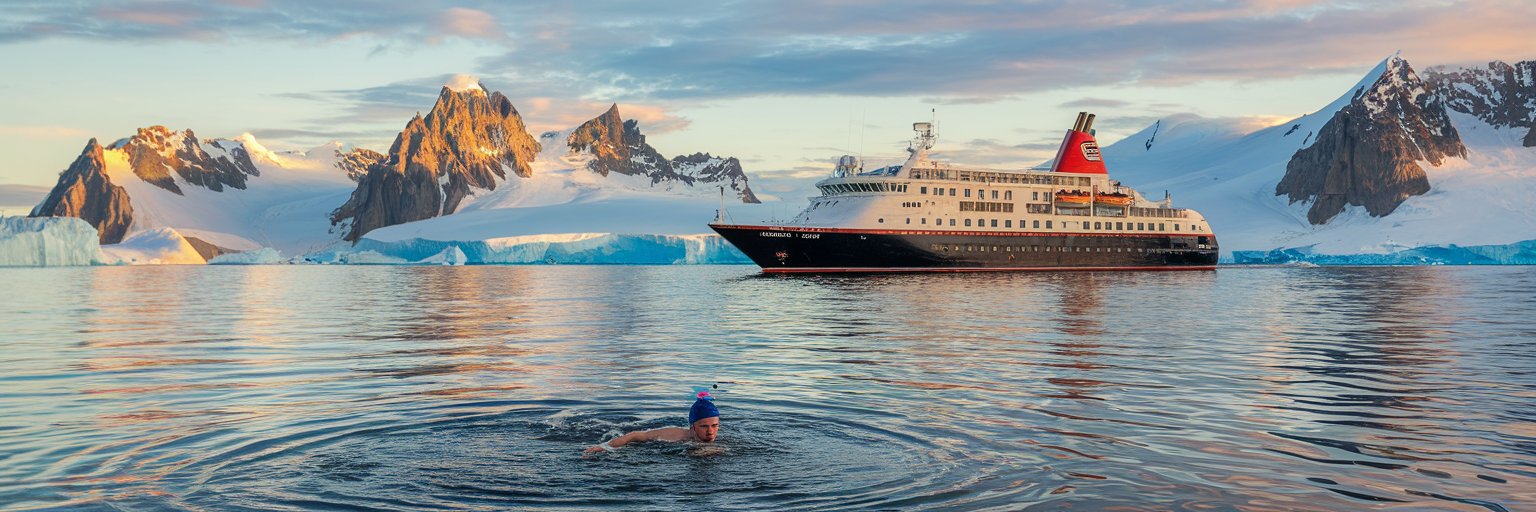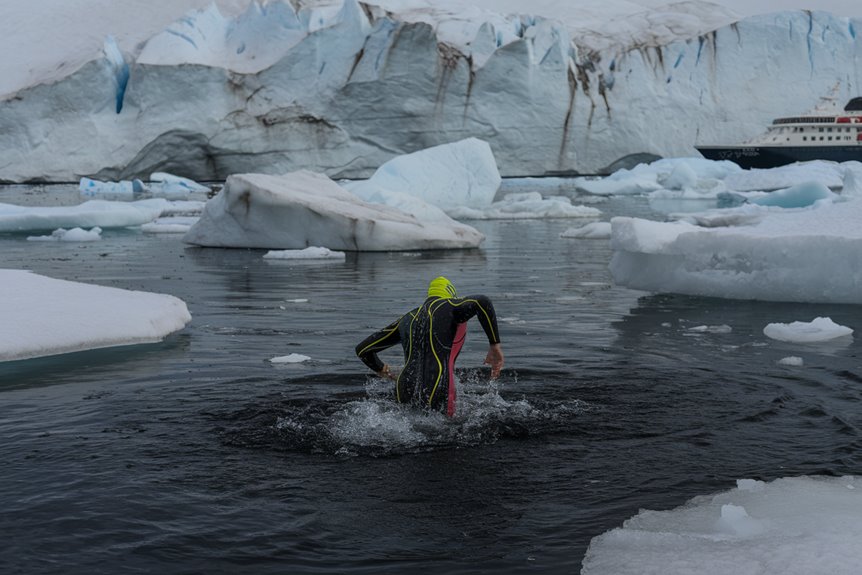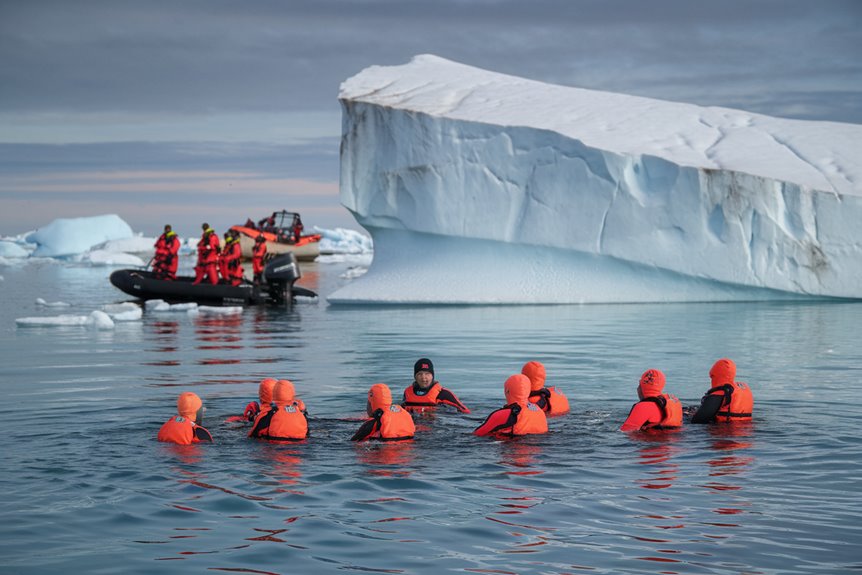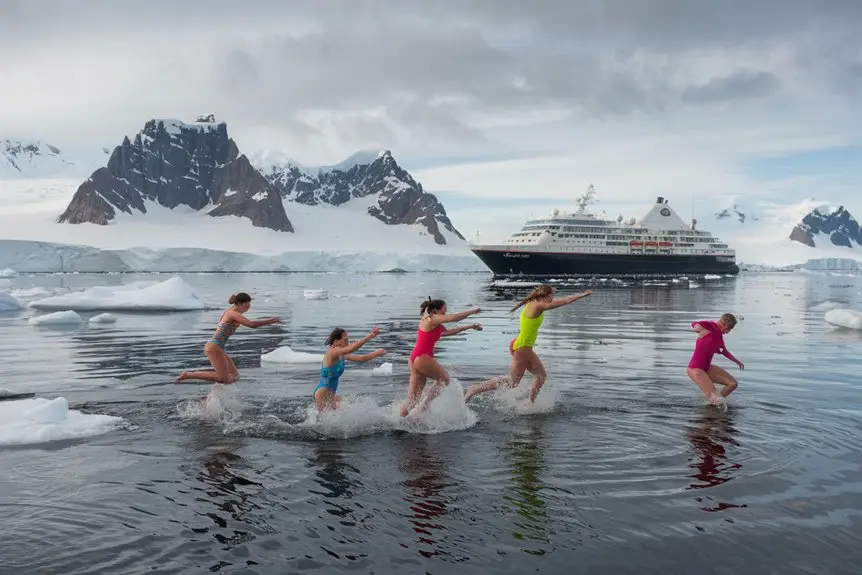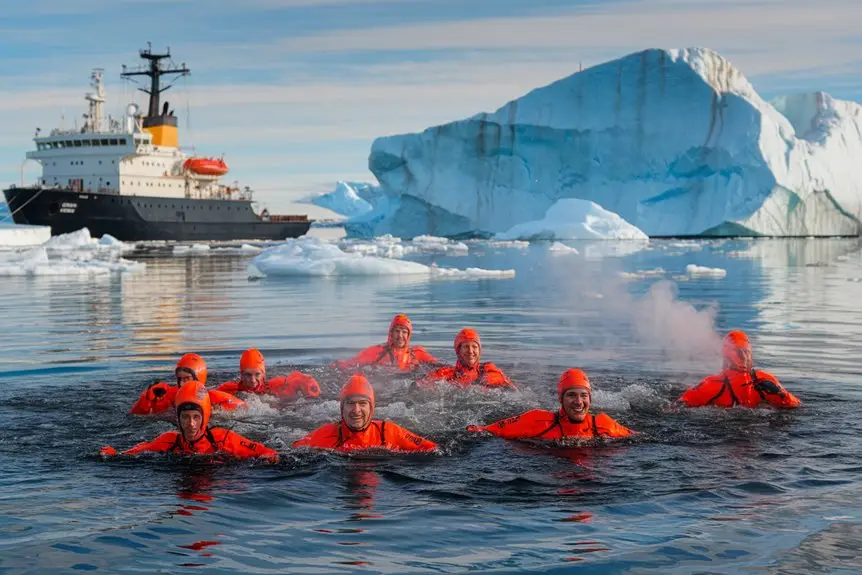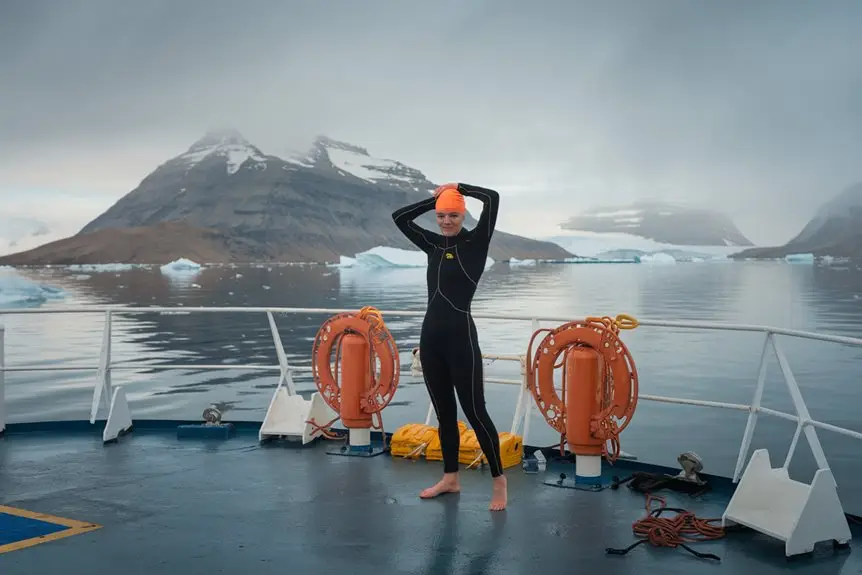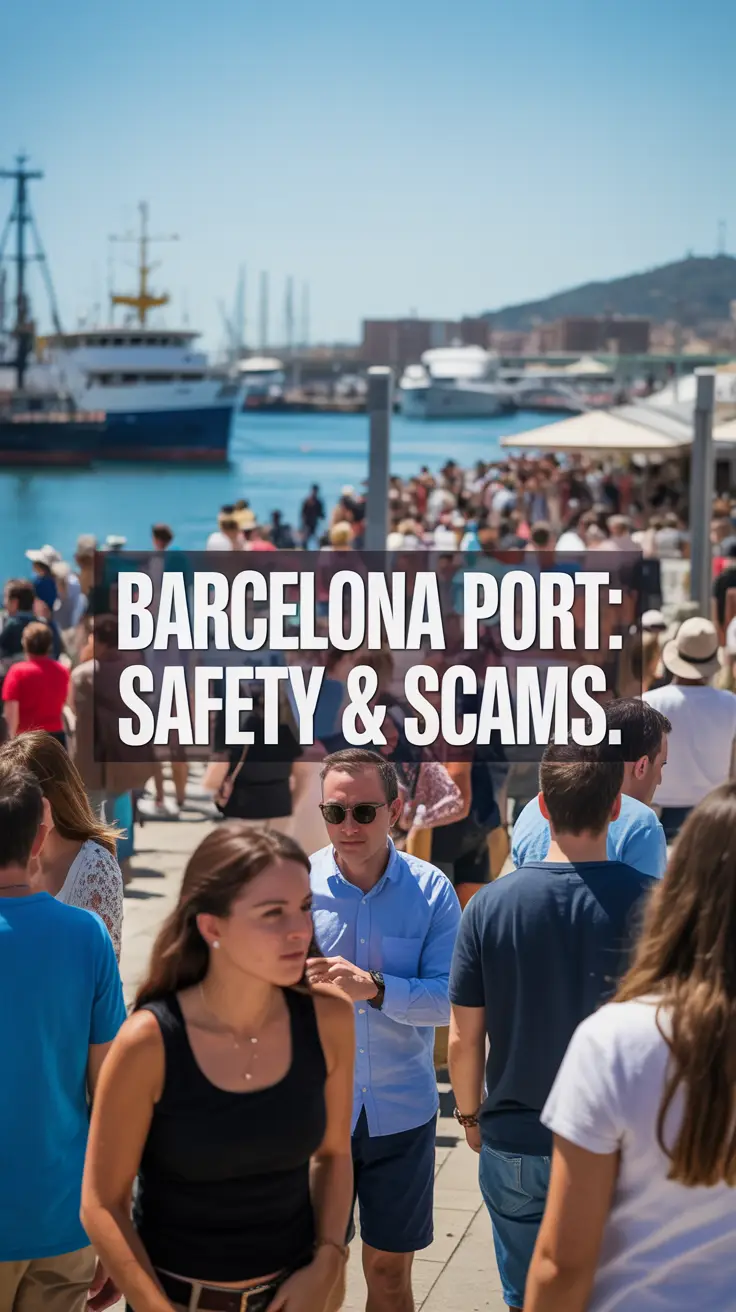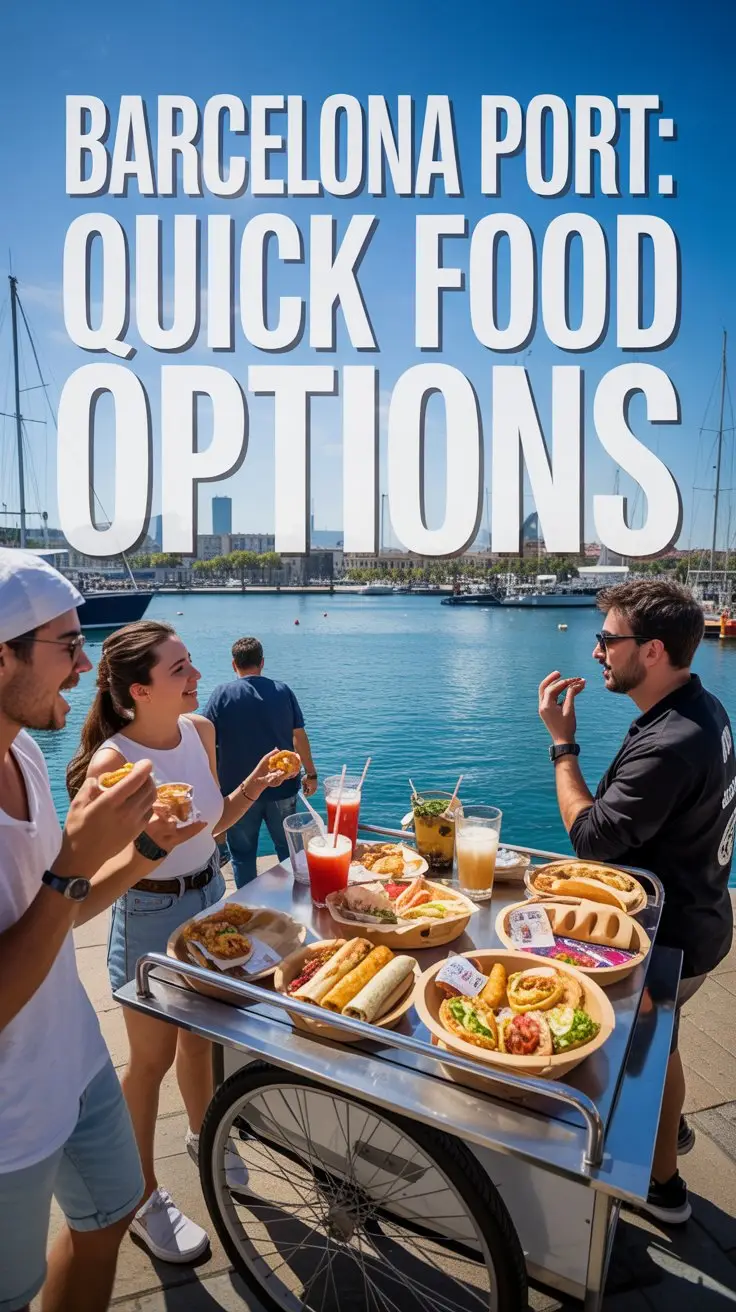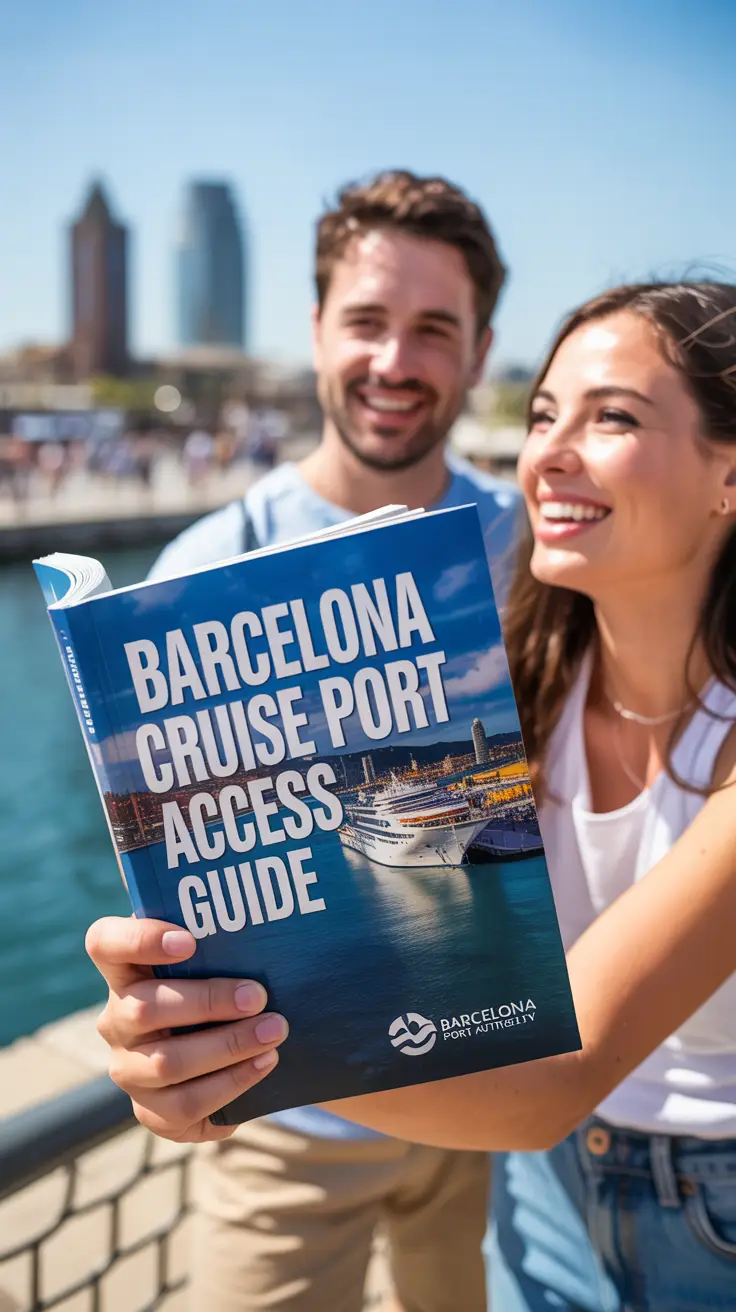Swimming options on polar cruises range from quick polar plunges to guided ice swimming sessions. You can experience the planet’s coldest waters with complete safety, as trained crew members supervise every activity.
For short plunges (3-5 minutes), you need basic swimwear. For longer swims, you’ll wear a protective survival suit. The ship’s icebreaker platform provides a stable entry point into the water.
You’ll receive expert guidance throughout your swim, regardless of your experience level. Each swimming session concludes with a warming drink, and you get a certificate to mark your achievement.
The key requirements include:
- Following safety briefings
- Wearing provided safety gear
- Listening to crew instructions
- Completing medical checks
You should prepare by:
- Bringing suitable swimwear
- Packing a warm robe
- Getting a basic health check
- Mentally preparing for the cold
🐧 Polar Cruise Enquiry 🐻❄️
Our team of polar travel specialists have personally explored both the Arctic and Antarctic regions – from tracking polar bears in Svalbard to kayaking with penguins off the Antarctic Peninsula. Let us find the right polar expedition cruise for you.
Key Takeaways
You’ll get to experience polar swimming through these safe, exciting activities:
Your Polar Plunge:
- You’ll swim for 3-5 minutes in icy waters
- You’ll wear a safety harness
- You’ll have rescue teams watching over you
Swimming from Your Ship:
- You’ll swim in marked-off areas near the ship
- You’ll wear a floating survival suit
- You’ll explore waters 10-15 metres deep
After Your Swim:
- You can warm up in the hot tubs and saunas
- You’ll receive a glass of champagne
- You’ll get a certificate to mark your achievement
Your Safety:
- You must wear a survival suit
- You’ll have trained rescue crews nearby
- You’ll see Zodiac boats ready for emergencies
Water Conditions:
- Antarctic waters reach -10°C
- Arctic waters hover around 0°C
- You’ll need a health check before swimming
The Polar Antarctic Ice Swimming
Polar Antarctic ice swimming tests your physical limits in extreme cold waters. You need extensive training over multiple years to handle temperatures below 5°C. Your swimming gear remains minimal: just a costume or trunks, swimming cap and goggles.
You’ll become part of a select group of swimmers from 19 countries who tackle this challenge. To qualify, you must swim 1,000 metres in Antarctic waters below 60°S latitude.
Your body will show clear warning signals if you stay too long in the freezing water: watch for clawed fingers and slower swimming strokes.
Two remarkable achievements stand out in this sport: Lynne Cox swam 1.96 km at Neko Harbour in 2002, and Cath Pendleton completed an ice mile inside the Antarctic Polar Circle.
Safety First in Polar Waters
You need specific safety measures when travelling in polar waters.
Your essential requirements:
- Wear tested insulated immersion suits
- Carry Personal Survival Kit
- Carry Group Survival Kit
Your safety training includes:
- Mandatory emergency drills
- Ice and water survival techniques
- Hypothermia response training
- Life-saving equipment practice
Your ship must have:
- Working emergency equipment tested for extreme cold
- Trained crew members for polar emergencies
- Clear Polar Water Operational Manual
- Reliable communication systems
Your responsibilities:
- Check all safety gear yearly
- Learn emergency procedures
- Follow safety protocols strictly
- Know your vessel’s safety limits
Remember: The polar environment affects your safety equipment and rescue operations.
Your preparation and knowledge directly impact your safety in these waters.
Traditional Polar Plunge Experience
Want to try something extraordinary? The Polar Plunge started at Coney Island in 1903 and now takes place on cruise ships in the Arctic and Antarctic waters.
You will experience water temperatures between -10°C in Antarctica and 0°C in the Arctic. You can jump from either the ship’s gangway or a Zodiac boat. Your safety comes first, so you’ll wear a harness with a safety line, and rescue teams will stay close by in Zodiacs.
The ship’s team will pick the best time for your plunge based on the weather. You’ll spend just 3-5 minutes in the water to stay safe from hypothermia.
After your brave swim, you can warm up in the ship’s hot tub or sauna while enjoying champagne with your fellow plungers. You’ll also receive a certificate to prove your polar achievement.
Icebreaker Swimming Adventures
Take a chilly dip from our mighty icebreaker ships in the Bothnian Sea. Our vessels measure 78 metres in length and feature seven spacious decks.
The ships carve out safe swimming areas in the frozen waters, which reach depths of 10-15 metres. You’ll stay completely safe in your floating survival suit, making this adventure perfect for swimmers of all levels.
The friendly crew will guide you through essential safety steps before your swim. You can explore the ship’s fascinating areas, including the engine room and Captain’s bridge.
Your polar swimming experience ends with a cosy moment in the ship’s saloon. You’ll warm up with steaming hot drinks whilst the captain awards you a special Cruise and Swim Certificate.
This unique document proves you’ve conquered the icy waters of the Nordic seas.
Preparing for Polar Swimming
Getting ready for polar swimming needs careful steps and preparation.
You should visit your doctor for a health check first. This matters most if your family has heart problems or high blood pressure.
Start by training your body to handle cold water bit by bit. This helps prevent cold shock.
Train in swimming pools where you can control the water temperature. This lets you practise for real polar conditions.
Break your training into clear zones:
- High-energy swimming bursts
- Rest periods between efforts
- Gradual increase in cold exposure
Protect yourself with basic safety kit:
- Earplugs to prevent hearing damage
- Swim cap to keep your head warm
- Heart rate monitor to track your effort
Use these training tools to build strength:
- Swimming paddles for arm power
- Pull buoys for leg position
- Ankle bands for technique work
Keep track of your heart rate during training to stay within safe limits. This helps you build endurance without risking your health.
Frequently Asked Questions
What Happens if a Swimmer Gets Leg Cramps During a Polar Swim?
You need to act quickly if leg cramps strike during a polar swim. Your immediate steps are:
- Stay calm and float on your back
- Stretch your cramping leg muscles whilst keeping your body as still as possible
- Signal to your safety team for help
- Keep your breathing steady and controlled
- Move slowly towards the exit point or safety boat
Your body temperature drops rapidly in polar waters, so you mustn’t waste energy fighting the cramp. Let your flotation gear support you whilst you manage the pain. The cold water makes muscle cramps more intense, but gentle stretching helps ease them. Your support team should reach you quickly once you signal for assistance.
Remember: Quick action and staying calm are your best tools for managing cramps in polar conditions.
Can Participants Wear Regular Swimming Goggles in Polar Water Temperatures?
You need specialised cold-water goggles for polar swimming, as regular swimming goggles aren’t suitable. Standard goggles can crack in extreme temperatures and develop severe fogging issues. Your safety depends on using proper polar swimming equipment that protects your eyes from the harsh conditions. Cold-water goggles offer better insulation and anti-fog properties that you’ll need in polar temperatures.
Is Underwater Photography Allowed During Polar Swimming Activities?
Underwater photography rules vary for polar swimming activities, and you need to check with your specific tour provider. Most operators allow waterproof cameras during guided snorkelling sessions. You must follow safety protocols and wildlife guidelines whilst photographing. Keep your equipment secure and maintain a safe distance from marine life. Your guide will brief you on local regulations and best practices before entering the water.
How Long Does It Take to Recover Body Temperature After Swimming?
Your body needs 1-2 hours to return to its normal temperature after swimming. You can speed up your recovery by following these simple steps:
- Get into warmth straight away
- Take a warm shower
- Put on dry clothes
- Sip a hot drink
These actions help your core temperature stabilise more quickly and prevent post-swim chills. The warmer your environment, the faster your body will readjust.
Are There Age Restrictions for Participating in Polar Swimming Events?
Polar swimming events typically don’t set strict age limits. You must complete three key requirements before participating:
- Pass a general fitness test
- Obtain medical clearance from your doctor
- Show proof of cold-water swimming experience
Your safety remains the primary concern, so organisers will assess your readiness regardless of your age. You’ll find most events focus on your physical capability rather than your age bracket.
🐧 Polar Cruise Enquiry 🐻❄️
Our team of polar travel specialists have personally explored both the Arctic and Antarctic regions – from tracking polar bears in Svalbard to kayaking with penguins off the Antarctic Peninsula. Let us find the right polar expedition cruise for you.

